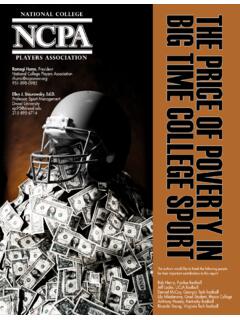Transcription of The Importance of National Symbols to National Identity
1 The Importance of National Symbols to National Identity National Symbols are very important to National Identity . The Importance of National Symbols can vary, depending on the strength, history, and political environment of the nation. However, Symbols are easily identified, and are used to "direct and organize, record and communicate."[1]. National Symbols are easily recognized entities that are used as means to communicate the history and culture of a particular nation. These Symbols can be used to instill pride and unity in a nation's population. National Symbols can be a single entity, such as the Eiffel Tower, an easily reproduced item such as a nation's flag, or something more intangible, such as a National anthem.
2 National Symbols are often displayed at many major events, such as sporting contests. Symbols are used to signify the Importance of holidays and other days of observation. For example, in the United States, a flag-bearing ceremony occurs, with a rendering of the National anthem, before a National Football League (NFL), Major League Baseball (MLB), or National Basketball Association (NBA) game is played. The pomp and circumstance that surrounds the ceremony is often tied in with recognition of the nation's active or retired soldiers, with the unfurling of football field flags and Air Force flyovers. Patriotism is further on display simply with the logos of these leagues. The official logo of the NFL is red, white, and blue, featuring white stars on a blue background, in a similar design to the American flag.
3 Similarly, both MLB and the NBA. invoke the National symbolism of the United States with official emblems that prominently display the colors of the flag. Of course, this phenomenon is not unique to the United States. In the Olympic Games, the National flags of the top three contenders in each athletic event are displayed while the winner's National anthem is played. Who can forget the National pride displayed by sprinter Usain Bolt who, upon winning a race at the 2008 Olympics, seized the Jamaican flag and held it high as he and his countrymen celebrated his victory? In the United States there are at least four holidays in which the American flag, and all things red, white, and blue are featured prominently.
4 We recognize Flag Day, which celebrates the flag, Veteran's Day, in which military veterans are honored, Memorial Day, when we honor and mourn those who gave their lives in service of their country, and Independence Day, in which we celebrate our break from the British empire. All of these holidays are considered National holidays. We have parades, we place flags at gravesites, we dress up as Uncle Sam (another National symbol), and we wear the colors of the flag. Importantly, parades and flag waving reinforce the patriotism of American citizens who participate in these events, often extending beyond the date of the celebration. Jon E. Fox and Cynthia Miller-Idriss note that "[w]hile such experiences of exultation are necessarily infrequent and ephemeral, their impact on the National sensibilities of the ordinary people who engage in them can be more durable.
5 "[2]. This essay begins with a short look at relevant literature about the Importance of National Symbols . Symbols are meant to express the history and culture of a nation. Modern studies in The Importance of National Symbols to National Identity psychology suggest that the impact of Symbols is understood when the underlying structure of the symbol and the symbol's use and display are better understood. The essay then turns to examples of National Symbols , including the flags of the United States and South Africa, the Eiffel Tower, and the Great Wall of China. Human beings are social creatures. We join, and identify with, many different groups. Some of these groups are seemingly unimportant such as identifying with others who drink the same soda or beer.
6 Some of the groups are activity based, such as those who smoke or those who play fantasy games. Others are unimportant, yet take on a life of their own. Sports fans know the feeling of euphoria when "their" team wins, or despair when that team loses. Those fans also know the feeling of unity with the fans in the stands or local bar who are rooting for the same team. Allegiance to one's country has roots in the social psychology of humankind. According to David A. Butz, "[p]rimitive forms of National attachment, such as attachment to tribes, chiefdoms, or states, may have existed even thousands of years prior to the first documentation of modern forms of National attachment."[3] Part of this attachment to the nation is the common understanding of the Symbols of that nation.
7 Butz continues by noting that " .. National Symbols often do not only represent the general concept 'nation,' but also condense the knowledge, values, history, and memories associated with one's nation. Further, it is clear that National Symbols also hold the potential to represent the strong emotional attachments felt for one's nation."[4] He also notes that exposure to the National Symbols of one's country can impact people's attitudes and actions. Importantly, these Symbols can be of varying types. Fox and Miller-Idriss acknowledge that these Symbols can include "[s]ongs sung, chants chanted, banners unfurled, and flags waved."[5] In short, people often identify more strongly with their nation, and their fellow citizens, when exposed to Symbols of their nation.
8 Similarly, Karen A. Cerulo notes that National Symbols are used "to direct public attention, integrate citizens, and motivate public action" and in "creating bonds and reinforcing goals among .. citizens." National Symbols are so strong that they "clarify and create society."[6] Yet, Cerulo notes that the type of symbol used can fluctuate based on the history and culture of the country and the needs of the National leaders. In her study of National anthems, she notes differences in music types between democratic and unitary forms of government, the political environment of the nation and the part that the country played internationally at the time the National anthem was composed. In other words, although every nation in the world has its Symbols , the structure, function, and style of the symbol may vary across nations.
9 There is also an impressive literature, led by Michael Billig's Banal Nationalism, which purports that National Symbols affect National Identity far beyond the pomp and circumstance of flag displays and flyovers at sporting events and the parades and flag waving of National holidays. The Importance of National Symbols to National Identity These everyday, "banal" examples of National symbolism and Identity can be seen in the flags flown at schools and government buildings nationwide, by the daily Pledge of Allegiance recited by schoolchildren, and by the sports organizations discussed above that utilize the Symbols of the state for the Symbols of sport. Indeed, Michael Skey, in a discussion of Billig's contribution, notes that "it is through everyday language and practices that identities gain credence.
10 "[7]. Therefore, the long-term impact of National symbolism at special events, when coupled with the everyday displays of National Symbols , creates an environment in which everyday citizens can connect with their nations daily, often in unnoticed ways. Thus, "[f]lags don't have to be saluted or waved to work their National magic. The near complete assimilation of nationhood into the realm of the ordinary not its sporadic or spectacular invocations testifies to its prosaic power."[8]. The Symbols of four countries have been selected for discussion so that the reader might understand tangible and intangible Symbols , taken from across the globe, including both developed and developing countries. It is important to note that flags of two very different countries are included in this discussion in large part because flags are most often considered to be symbolic of the nation.




